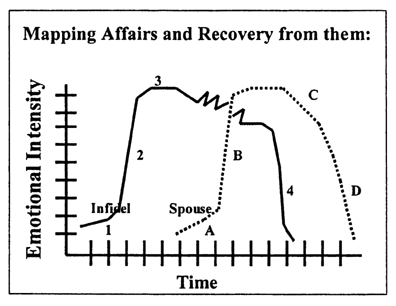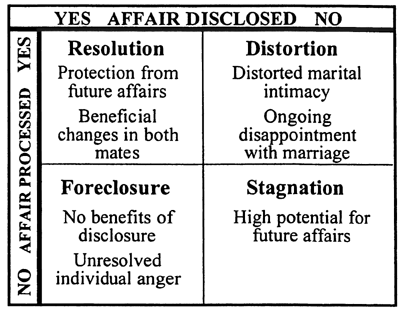Torn Asunder: Charts & Maps
Four Classes of Affairs
|
CLASS I
|
CLASS II
|
CLASS III
|
CLASS IV
|
|
| Biblical Illustration | David & Bathsheba | Samson & Delilah | Eli’s sons | Abraham & Hagar |
| Description | One-night stand | Long-term relationship | Multiple partners/ sexual addiction | Satisfies a specific marital void |
| Development | Immediate | Gradual | Impulsive | Gradual, focuses on marital void |
| Emotional Involvement | None | Intense | None | Intense, with narrow boundaries. No dating, gifts, plans for marriage |
| Sexual Activity | Single experience; intense, lustful, passionate | Only much later – after friendship established | Immediate and repeated with multiple partners and increasingly distorted sex | Irregular, often without mutual enjoyment |
| Remorse/Repentance | Usually immediate and intense | Initially none; only grief for lost relationship | Only after acting-out episode; internal tension until another episode is inevitable | Regular, but marital void “drives” re-connection |
| Recovery | Can be immediate with forgiveness | Long-term process with marital therapy | Sobriety first; then individual therapy; marital therapy later | Long-term process with marital therapy |
Mapping Affairs and Recovery from Them
This chart shows the process most Class II Affairs move through. Two general concepts are apparent:
- The spouse needs the freedom to have the same amount of time to recover as the infidel took during the affair.
- The spouse must be as emotionally engaged in the “After Disclosure” process as the infidel was in the affair. To “sweep it under the rug, to forgive and move on, to pretend that this is not worth ruining the marriage, etc.”, is to guarantee an incomplete healing.

Infidel
Phase 1—Growing Mutual Attraction:
Growing feelings of attraction; still platonic until feelings of mutual attraction are shared
Phase 2—Emotional and Sexual Entanglement:
Start of the affair though erotic activity might not start for some time
Phase 3—Destabilization of the Affair:
Infatuation lessens, guilt encourages partners to try to stop relationship, but concern for each other encourages contact on an irregular basis
Phase 4—Disclosure and Resolution:
Depression, exhaustion, guilt, shame, discovery, etc., cause infidel to want to just “put it behind” him and move on
Spouse
Phase A—Awareness:
Noticing changes in mood, expenditures, schedule, appearances: The spouse develops a nagging concern that is initially discounted by her
Phase B—Anger:
Full blown suspicion, accusations, crying initiated; bouts of depression followed by anxiety and fear
Phase C—Anguish:
Anger, grilling and “putting the puzzle together” (dates, places, phone calls, etc.)
Phase D—Reattachment and Recovery:
Resolution, forgiveness, respect, and trust initiated
After Disclosed & Affair Processed
1. The non-affair spouse is in charge of both the timing and the amount of information flow.
2. If not disclosed, these secrets can be recalled by the infidel at will later on for personal enjoyment. However, once they are disclosed, the experiences appear to lose much of their attractiveness.
3. The most common justification for not providing full disclosure is if there is a history of violence or rage within or between the spouses. This concern usually surfaces when the wife has an affair and the marriage has a history of severe conflict and abuse.
4. The infidel needs forgiveness and the spouse can only forgive what he/she knows. You can’t forgive what you don’t know.
5. The faithful spouse always pays twice in this healing process: First, at disclosure of the affair. Second, when called on to forgive the specific details. It neither feels nor appears to be fair, but there is no other way for healing to take place.

For the Spouse
| Denial of Anger Is . . . | Genuine Forgiveness Is . . . |
| Unawareness of feelings | Acute awareness of all feelings |
| No vacillations in attitude | Cyclical/seasonal vacillation in attitude |
| Overly predictable relationship with tendency to gut it out, to “stay committed” (i.e., simply married) without much joy | Unpredictability at times—the normal roller coaster ride of a healthy marriage |
| No change in relationship style | Many changes, some of which are quite frightening |
| Focusing on projects outside the self | Focusing on the self and the marriage relationship |
| Acting out feelings, often injuring self and mater; or suppressing feelings | Ability to talk about feelings with mate |
| Nurturance received exclusively outside the marriage from friends, children, job | Beginning to give and receive nurturance from mate |
| Emotional heaviness; nothing as good as anticipated | Freedom, exhilaration, feeling unbelievably alive at times. |
| Never being thankful for the fallout of the affair | Gratefulness for the changes the affair has brought into the marriage and the infidel’s life |
| Refusal to discuss the affair with others who could benefit—intense feelings of shame | Ability to discuss the affair relatively pain-free, given appropriate processing and the passage of some time |
| Less respect than ever for the infidel; carries cloaked disdain for him/her | Greater appreciation developing for mate |
| mental accusations of multiple infidelities | Healthy, biblical sexuality; children benefit from new levels of family intimacy |
| Continually placing sole responsibility for condition of marriage on infidel | Growing awareness of his/her own shortcomings that contributed to the affair; shared responsibility |
| Victimized feelings (“one down”) or superior feelings (“one up”) | healthy sense of wholeness without comparing self to infidel—growing mutual self-respect |
Forgiveness List
Misconceptions and bad practices surrounding forgiveness are the biggest mistakes most couples make.
- Forgiveness at this level of betrayal needs to be asked for. To voluntarily offer it without the infidel acknowledging their behavior is inappropriate and counter-productive to the healing process.
- Forgiveness should not be asked for or granted as a “blanket” experience. There are multiple levels of betrayal that need to be identified and forgiven. Besides, it allows the spouse to process small pieces of the betrayal without having to handle the entire experience all at once.
- The forgiveness request should not only identify each specific behavior of the infidel, but should also contain a “best guess” identification of how this behavior hurt the spouse. (See Workbook, Chapter 4)
- Forgiveness is not the same as a commitment to reconcile the marriage. Forgiveness needs to be initiated, whether or not the marriage is saved.
- The forgiveness process stimulates the rebuilding of respect, trust and love. It works like this: To the degree an individual can forgive some of the violations that occurred in this betrayal, to that degree they can begin to rebuild respect. To the degree they can rebuild respect, they can rebuild trust. To the degree that they can rebuild trust, they can start to rebuild love (if both spouses desire to do so).
- The ability to forgive is a learned skill and highly influenced by an individual’s history with both being forgiven and forgiving others. If an individual struggles in this area, it often has more to do with their history than with the current infidelity.
